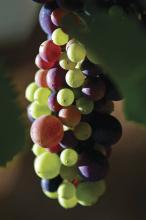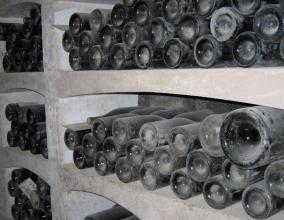Wines
Names
• Bourgogne "Chardonnay"
• Bourgogne "Les Bons Batons"
• Bourgogne "Pinot Noir"
• Côte de Nuits Villages "vieilles vignes"
• Chambolle-Musigny 1er Cru "Les Charmes"
• Chambolle-Musigny "Les Cras"
• Chambolle-Musigny "vieilles vignes"
• Nuits Saint Georges "Aux Barrières"
• Nuits Saint Georges 1er Cru "Clos des Argillières"
• Nuits Saint Georges 1er Cru "Clos Saint Marc"
• Nuits Saint Georges 1er Cru "Les Hauts Pruliers"
• Nuits Saint Georges 1er Cru "Les Terres Blanches"
• Nuits Saint Georges "Vieilles Vignes"
• Vosne Romanée 1er Cru "Les Beaux-Monts"
• Vosne Romanée "village"
 When an appellation has one single owner/producer, it’s known as a monopole (monopoly). Burgundy is so complex, with so many small parcels of vines, that owning a "private" vineyard is very special. Monopoles manage to be kept intact over time frequently because they are walled vineyards – called Clos -- in the heart of a village, and enclose just a small area. We want to call your attention to eight monopoles from our village, the so-called Nuits de Premeaux (Nuits from Premeaux). These wines are mostly 1er Crus, and they possess great finesse and elegance.
When an appellation has one single owner/producer, it’s known as a monopole (monopoly). Burgundy is so complex, with so many small parcels of vines, that owning a "private" vineyard is very special. Monopoles manage to be kept intact over time frequently because they are walled vineyards – called Clos -- in the heart of a village, and enclose just a small area. We want to call your attention to eight monopoles from our village, the so-called Nuits de Premeaux (Nuits from Premeaux). These wines are mostly 1er Crus, and they possess great finesse and elegance.
Vintages
2021: a fresh wind
March was warm and the sap of the vine started quite early to get its bud burst. Then the 4th April came a huge an massive frost that burned all the green parts of the buds, the loss was very important for many cultures. May and June were quite wet and cold month, giving some problems to the vinegrower. Hopefully end of August and September were luminous enough to ripen the small crop. The harvest started the 18th of September by the Clos St Marc giving small yields of 15hl/ha .
Classic
Both colours are finally getting the same expression of freshness and purity. The premiers crus of course are showing even better as the wines are deeper.
The wines will be available at spring 2023.
Vintages 2007 | 2008 | 2009 | 2010 | 2015 | 2016 | 2017 | 2018 | 2019 | 2020
Some tips
Corks - Screw caps - Synthetics
 Cork has done a great job for many years. But we have noted a decrease in quality over the last 10 years. Massive global wine production created a high demand for this product and the consequences can be felt in terms of quality. That's the reason why we have become more and more interested in alternative closures.
Cork has done a great job for many years. But we have noted a decrease in quality over the last 10 years. Massive global wine production created a high demand for this product and the consequences can be felt in terms of quality. That's the reason why we have become more and more interested in alternative closures.
Synthetic corks are not ideal, from our point of view, because they do not have the same elasticity as cork. Oxygen can get into the bottle making cellaring for long periods impossible.
So we focused on the screwcap (stelvin, a French invention) and started trials in 2003. The two different technical liners are more or less permeable to oxygen depending on the winemaker’s choice (and the product itself, differentiating red and white wines). We have never been disappointed by a wine under screwcap. It evolves less quickly, but freshness is better preserved. We clearly recommend this for all our white wines, and regular reds such as Bourgogne and Côte de Nuits Villages.
The customer would be wise to change his mind set about this alternative. The UK is open to making the change, but some other markets remain wedded to the traditional cork. One last point: the cost of a good cork is higher than the screwcap, but the glass bottle required for it is more expensive. All in all, the cost balances out and so the economic aspect doesn't affect the choice.
Should I decant into a carafe to give oxygen to the wine?
That's a fair question, each time you open a bottle, white or red, young or old. The oxygenation which results from pouring the wine is useful to "open" the wine completely.
But our wines do not really need to be decanted; just open the bottle a few minutes beforehand to make it show better and better as it opens in the glass. That is one of wine’s great pleasures, getting to experience all its phases.
The problem is when you have many guests around the table, and the time given to the wine to open is too short. With guests, wine has to show well from the start, and so in this case I would recommend decanting.
It's also a good thing to do for a blind tasting, and it's a sign that you care about your wine.
Last piece of advice: if you open a good bottle with friends, limit the number of guests to make sure you have the time—and enough wine—to appreciate the different phases of the wine as it opens up.
My cellar
 Stability is the keyword for a good cellar. If you don't have a good cellar, the eurocave system can be a solution, otherwise you'll just have to visit your favorite winemaker often! The serious wine merchants we are working with can of course be helpful and advise on this issue...
Stability is the keyword for a good cellar. If you don't have a good cellar, the eurocave system can be a solution, otherwise you'll just have to visit your favorite winemaker often! The serious wine merchants we are working with can of course be helpful and advise on this issue...
Temperature
When you get ready to pour the wine, keep in mind that it’s better to have it a little too cool than too warm. Then the room temperature will complete the job, and will give you the time to appreciate the different expressions of the wine. 10-11°C for the whites, 16-17°C for the reds, are the range that we would recommend.
Food & Wine ?
Burgundy wines are first of all wines to accompany a great dinner. With their complexity and freshness they are the perfect partner for good food. Whether for a simple meal between friends, or for an elaborate evening dinner, the pleasure of choosing the wine adds spice to the event. The aim is to find the perfect combination with the food. This is surely part of the pleasure of being a host.
Remember, being a sommelier is an important job!

